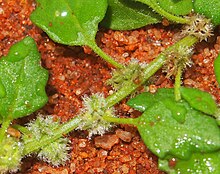Goosefoot
| Goosefoot | ||||||||||||
|---|---|---|---|---|---|---|---|---|---|---|---|---|
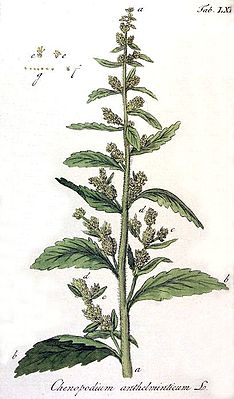
Worm seed goosefoot ( Dysphania anthelmintica ), illustration |
||||||||||||
| Systematics | ||||||||||||
|
||||||||||||
| Scientific name | ||||||||||||
| Dysphania | ||||||||||||
| R.Br. |
The glandular goosefoot ( Dysphania ) are a genus of plants in the foxtail family (Amaranthaceae). They are distributed worldwide from the tropics and subtropics to the warm-temperate zones.
description
Vegetative characteristics
The glandular goose feet are annual or short-lived perennial herbaceous plants . Their surface is covered with stalked or sessile glandular hairs, which gives the plants an aromatic (sometimes unpleasant) odor. Sometimes hairs with single-row, multicellular trichomes are also present, and the plants rarely bald. The upright, ascending or prostrate stem is usually branched.
The alternate leaves are usually stalked (in some species the upper leaves are sessile). Their leaf blade is linear, lanceolate, ovate or elliptical, often lobed pinnately, with a wedge-shaped or truncated base and entire, serrated or serrated leaf margin.
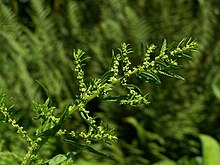
Inflorescence and flower
In terminal, loose, simple or compound pseudo-annual inflorescences are zymous partial inflorescences or dense axillary, knobby partial inflorescences . Bracts are missing or reduced.
The flowers are hermaphroditic (rarely unisexual). The inflorescence consists of one to five tepals , which are usually only connected at the base, but in some species have grown together to form a sack-like structure. There are one to five stamens . On the upper ovary there are one to three thread-like scars.

Fruits and seeds
The fruit is often enclosed by the flower envelope. The membranous pericarp rests more or less loosely on the horizontal or vertical, spherical to lenticular seeds. The red-brown or black seed coat is smooth or wrinkled. The ring-shaped or horseshoe-shaped embryo surrounds the abundant, floury nutrient tissue.
Chromosome number
The chromosome numbers given are 2n = 16, 18, 32, 36 and 48.
Photosynthetic pathway
The goosefoots are C 3 plants with normal leaf anatomy .
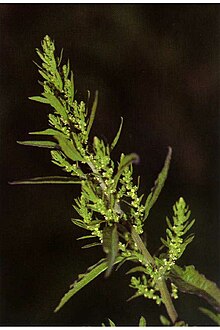



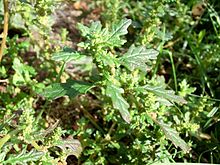

Occurrence
The goosefoot species are distributed worldwide from the tropics and subtropics to the warm-temperate zones. In Europe they occur naturally, as an archaeophyte or naturalized. Only in the north are they missing or only occasionally appear as adventitious plants .
There are four types in Germany and Austria:
- Mexican goosefoot , epazote ( Dysphania ambrosioides (L.) Mosyakin & Clemants )
- Worm Seed Goosefoot ( Dysphania anthelmintica (L.) Mosyakin & Clemants )
- Sticky goosefoot ( Dysphania botrys (L.) Mosyakin & Clemants )
- Australian goosefoot ( Dysphania pumilio (R.Br.) Mosyakin & Clemants )
- Schrader's goosefoot ( Dysphania schraderiana (Schult.) Mosyakin & Clemants )
Systematics
According to phylogenetic studies, the genus Dysphania belongs to the tribe Dysphanieae in the subfamily Chenopodioideae within the foxtail family (Amaranthaceae) and seems to be more closely related to the genera Suckleya and Cycloloma .
The genus Dysphania was first published in 1810 by Robert Brown . The type species is Dysphania littoralis R.Br. The generic name Dysphania comes from the Greek word dysphanis , which means indistinct, and probably refers to the inconspicuous flowers.
The genus Dysphania initially comprised only seven to ten species in Australia. At times these were even regarded as a separate family Dysphaniaceae Pax & Hoffmann or even assigned to completely different families (Illecebraceae and Caryophyllaceae). In 2002, Mosyakin & Clemants expanded the genus to include the glandular hairy species of the genus goosefoot ( Chenopodium subgenus Ambrosia A.J. Scott ). Other synonyms for Dysphania R.Br. are Neobotrydium Moldenke and Roubieva Moq.
Worldwide, the genus Dysphania includes five sections with around 42 species:
-
Dysphania sect. Adenois (Moq.) Mosyakin & Clemants : native to South and Central America with around 15 species, today distributed almost worldwide from the tropics to warm-temperate regions:
- Mexican goosefoot , Epazote ( Dysphania ambrosioides (L.) Mosyakin & Clemants , Syn .: Chenopodium ambrosioides L. ): This extremely diverse species is native to North and South America and is naturalized in other continents.
- Dysphania andicola (Phil.) Mosyakin & Clemants (Syn .: Ambrina andicola Phil. , Chenopodium ambrosioides var. Andicola (Phil.) Aellen )
- Worm seed goosefoot ( Dysphania anthelmintica (L.) Mosyakin & Clemants , Syn .: Chenopodium anthelminticum L. , Chenopodium ambrosioides var. Anthelminticum (L.) A.Gray ): Native to North America and the Caribbean, this species is also cultivated or naturalized in other continents.
- Dysphania burkartii (Aellen) Mosyakin & Clemants (Syn .: Chenopodium ambrosioides subsp. Burkartii Aellen , Chenopodium burkartii (Aellen) Vorosch. )
- Dysphania chilensis (. Schrad) Mosyakin & Clemants (Syn .: Chenopodium chilense . Schrad , Chenopodium ambrosioides var. Chilense (Schrad) Spegazzini. ; Chenopodium ambrosioides var. Vagans (Standley) JTHowell ) located in Argentina and Chile.
- Dysphania dunosa (LESimón) Mosyakin & Clemants (Syn .: Chenopodium dunosum L.E.Simón )
- Slit-leaved gospel goosefoot ( Dysphania multifida (L.) Mosyakin & Clemants , Syn .: Chenopodium multifidum L. , Roubieva multifida (L.) Moq. , Teloxys multifida (L.) WAWeber ): This species is native to South America and widely as an introduced species widespread in tropical, subtropical and warm-temperate regions.
- Dysphania oblanceolata (Speg.) Mosyakin & Clemants (Syn .: Chenopodium ambrosioides var. Oblanceolatum Speg. , Chenopodium oblanceolatum (Speg.) Giusti )
- Dysphania retusa (Juss. Ex Moq.) Mosyakin & Clemants (Syn .: Chenopodium retusum Juss. Ex Moq. )
- Dysphania sooana (Aellen) Mosyakin & Clemants (Syn .: Chenopodium sooanum Aellen )
- Dysphania tomentosa (Thouars) Mosyakin & Clemants (Syn .: Chenopodium tomentosum Thouars )
- Dysphania venturii (Aellen) Mosyakin & Clemants (Syn .: Chenopodium ambrosioides subsp. Venturii Aellen , Chenopodium venturii (Aellen) Cabrera )
-
Dysphania sect. Botryoides (Camey.) Mosyakin & Clemants : with two sub-sections:
-
Dysphania sect. Botryoides subsect. Botrys (Aellen & Iljin) Mosyakin & Clemants : with around nine species with worldwide distribution, native to southern North America, northern South America, southern Eurasia and Africa.
- Sticky gospel goosefoot ( Dysphania botrys (L.) Mosyakin & Clemants , Syn .: Chenopodium botrys L. ): Its distribution area includes Central, Southern and Eastern Europe, the temperate regions from Asia to the Chinese Xinjiang. Naturalized or cultivated, it also occurs in other temperate regions.
- Dysphania nepalensis (Colla) Mosyakin & Clemants (Syn .: Chenopodium nepalense Colla ), in Central Asia
- Dysphania procera (Hochst. Ex Moq.) Mosyakin & Clemants (Syn .: Chenopodium procerum Hochst. Ex Moq. )
- Dysphania pseudomultiflora (Murr) Verloove & Lambinon (Syn .: Chenopodium foetidum subsp. Pseudomultiflorum Murr ): native to South Africa.
- Schrader's goosefoot ( Dysphania schraderiana (Schult.) Mosyakin & Clemants , Syn.Chenopodium schraderianum Schult. )
-
Dysphania sect. Botryoides subsect. Incisa (Standley) Mosyakin & Clemants : with three species in southwestern North America and in South America:
- Dysphania dissecta (Moq.) Mosyakin & Clemants (Syn .: Ambrina dissecta Moq. , Chenopodium dissectum (Moq.) Standley )
- Fragrant goosefoot ( Dysphania graveolens (Willd.) Mosyakin & Clemants , Syn .: Chenopodium graveolens Willd. , Chenopodium incisum Poiret , Teloxys graveolens (Willd.) WAWeber ): It is native to North and South America, it is also introduced in other continents in front.
- Dysphania mandonii (S.Watson) Mosyakin & Clemants (Syn .: Teloxys mandonii S.Watson , Chenopodium mandonii (S.Watson) Aellen )
-
Dysphania sect. Botryoides subsect. Botrys (Aellen & Iljin) Mosyakin & Clemants : with around nine species with worldwide distribution, native to southern North America, northern South America, southern Eurasia and Africa.
-
Dysphania sect. Dysphania , with about eight species, all of which only occur in Australia:
- Dysphania glandulosa Paul G. Wilson
- Dysphania glomulifera Paul G.Wilson (Syn .: Dysphania myriocephala Benth. , Chenopodium myriocephalum (Benth.) Aellen )
- Dysphania kalpari Paul G. Wilson
- Dysphania littoralis R.Br.
- Dysphania plantaginella F. Muell.
- Dysphania platycarpa Paul G. Wilson
- Dysphania rhadinostachya (F. Muell.) AJScott (Syn .: Chenopodium rhadinostachyum F. Muell. )
- Dysphania simulans F. Muell. & Tate ex Tate
- Dysphania sphaerosperma Paul G. Wilson
- Dysphania valida Paul G. Wilson
-
Dysphania sect. Orthospora (R.Br.) Mosyakin & Clemants : with about seven species native to New Zealand and Australia, some species have also been introduced in other regions:
- Keeled Goosefoot ( Dysphania carinata (R.Br.) Mosyakin & Clemants , Syn .: Chenopodium carinatum R.Br. ): It is native to Australia and is also naturalized in other continents.
- Crested Goosefoot ( Dysphania cristata (F.Muell.) Mosyakin & Clemants , Syn .: Blitum cristatum F.Muell. , Chenopodium cristatum (F.Muell.) F.Muell. ): It is native to Australia and also grows in Australia other continents.
- Dysphania melanocarpa (JMBlack) Mosyakin & Clemants (Syn .: Chenopodium carinatum var. Melanocarpum J.M.Black , Chenopodium melanocarpum (JMBlack) JMBlack )
- Australian goosefoot ( Dysphania pumilio (R.Br.) Mosyakin & Clemants , Syn .: Chenopodium pumilio R.Br. , Teloxys pumilio (R.Br.) WAWeber ): It is native to Australia and grows naturalized in other continents.
- Dysphania pusilla Mosyakin & Clemants (Syn .: Chenopodium pusillum Hook. F. )
- Dysphania saxatilis (Paul G.Wilson) Mosyakin & Clemants (Syn .: Chenopodium saxatile P.G.Wilson )
- Dysphania truncata (Paul G.Wilson) Mosyakin & Clemants (Syn .: Chenopodium truncatum P.G.Wilson )
-
Dysphania sect. Roubieva (Moq.) Mosyakin & Clemants
- Argentine goosefoot ( Dysphania bonariensis (Hook.f.) Mosyakin & Clemants , Syn .: Roubieva bonariensis Hook. F. , Chenopodium haumanii Ulbr. )
- Dysphania microcarpa (Phil.) Mosyakin & Clemants (Syn .: Roubieva microcarpa Phil. )
- Species not yet assigned to a section:
- Dysphania congolana (Hauman) Mosyakin & Clemants (Syn .: Chenopodium glaucum var. Congolanum Hauman , Chenopodium congolanum (Hauman) Brenan ), in Africa.
- Dysphania minuata (Aellen) Mosyakin & Clemants (Syn .: Chenopodium minuatum Aellen )
- Dysphania stellata (Standley) Mosyakin & Clemants (Syn .: Chenopodium stellatum S. Watson ): This species is characterized by six to eight bracts.
Teloxys aristata (L.) Moq is no longer included in this genus . (Syn. Dysphania aristata (L.) Mosyakin & Clemants , Chenopodium aristatum L. ), which according to phylogenetic studies by Fuentes et al. (2011) is separated as a separate genus Teloxys .
use
Mexican goosefoot or epazote ( Dysphania ambrosioides ) is a medicinal plant and tea plant that is used in many ways . It is also used as an insecticide against lice and bed bugs.
Some Dysphania TYPES find as dye plants use.
literature
- Steven E. Clemants, Sergei L. Mosyakin: Dysphania. In: Flora of North America Editorial Committee (Ed.): Flora of North America North of Mexico . Volume 4: Magnoliophyta: Caryophyllidae, part 1 . Oxford University Press, New York / Oxford a. a. 2003, ISBN 0-19-517389-9 , pp. 267 (English, online ). (Sections Description, Occurrence, Systematics).
- Sergei L. Mosyakin, Steven E. Clemants: Further Transfers of glandular-pubescent species from Chenopodium subg. Ambrosia to Dysphania (Chenopodiaceae) . In: Journal of the Botanical Research Institute of Texas. Volume 2, No. 1, 2008, pp. 425-431 online (section systematics).
- Gelin Zhu, Sergei L. Mosyakin, Steven E. Clemants: Chenopodiaceae. Dysphania. In: Wu Zhengyi, Peter H. Raven, Deyuan Hong (Eds.): Flora of China . Volume 5: Ulmaceae through Basellaceae . Science Press / Missouri Botanical Garden Press, Beijing / St. Louis 2003, ISBN 1-930723-27-X , pp. 376 (English, online ). (Sections Description, Common Name).
- Dysphania , species list in Germplasm Resources Information Network (GRIN), USDA , ARS , National Genetic Resources Program. National Germplasm Resources Laboratory, Beltsville, Maryland. Retrieved November 30, 2011.
- Karl Peter Buttler , Michael Thieme u. a .: Flora List of Germany - Vascular Plants , Version 3 (August 2011) , accessed on November 30, 2011 (German trivial names of the species).
Individual evidence
- ↑ Erich Oberdorfer : Plant-sociological excursion flora . With the collaboration of Theo Müller. 5th, revised and expanded edition. Eugen Ulmer, Stuttgart (Hohenheim) 1983, ISBN 3-8001-3429-2 , pp. 342 .
- ↑ a b Gudrun Kadereit, Evgeny V. Mavrodiev, Elizabeth H. Zacharias, Alexander P. Sukhorukov: Molecular phylogeny of Atripliceae (Chenopodioideae, Chenopodiaceae): Implications for systematics, biogeography, flower and fruit evolution, and the origin of C4 Photosynthesis. In: American Journal of Botany , Volume 97, No. 10, 2010, pp. 1664-1687.
- ↑ a b Pertti Uotila: Chenopodiaceae (pro parte majore). Dysphania . In: Euro + Med Plantbase - the information resource for Euro-Mediterranean plant diversity. Berlin 2011, accessed November 30, 2011.
- ↑ a b Susy Fuentes-Bazan, Guilhem Mansion, Thomas Borsch: Towards a species level tree of the globally diverse genus Chenopodium (Chenopodiaceae) . In: Molecular Phylogenetics and Evolution. Volume 62, No. 1, 2012, pp. 359-374, DOI: 10.1016 / j.ympev.2011.10.006 .
- ^ Robert Brown : Prodromus florae Novae Hollandiae et Insulae Van-Diemen, exhibens characteres plantarum. Richard Taylor et socii, London 1810, p. 411, digitized .
- ^ Dysphania , Subsidiary Taxa at Tropicos.org. Missouri Botanical Garden, St. Louis, accessed November 30, 2011.
- ↑ a b Applications and ingredients of Dysphania ambrosioides from Liber Herbarum , accessed on November 30, 2011.
- ^ Applications of Dysphania schraderiana at Liber Herbarum , accessed on November 30, 2011.

